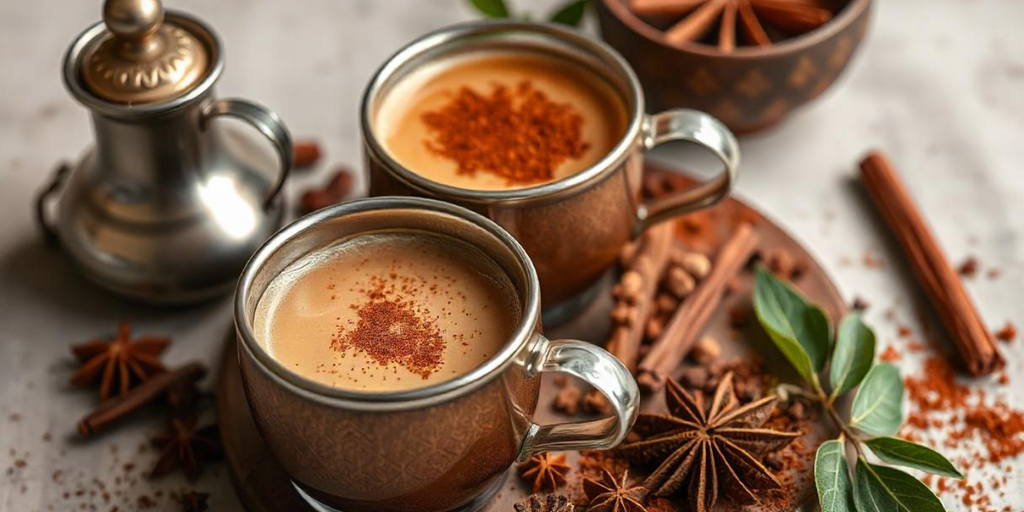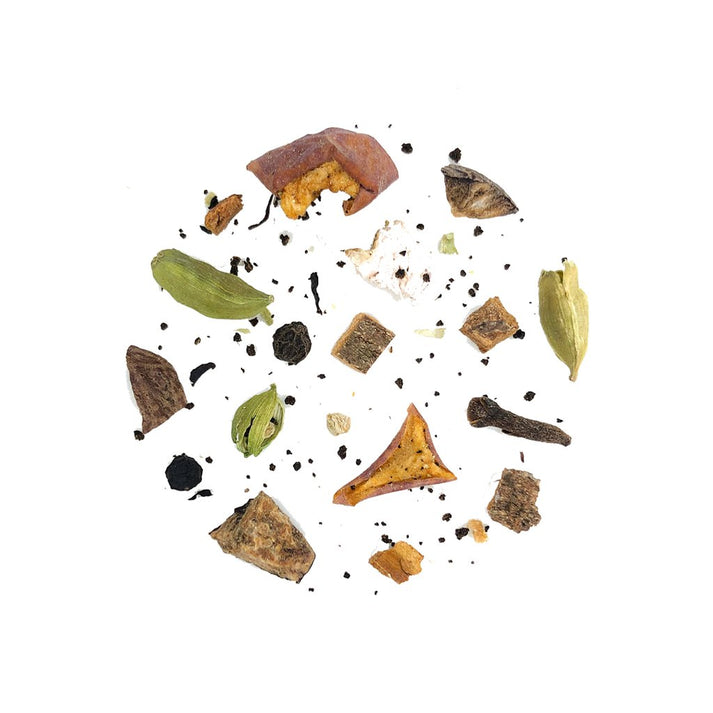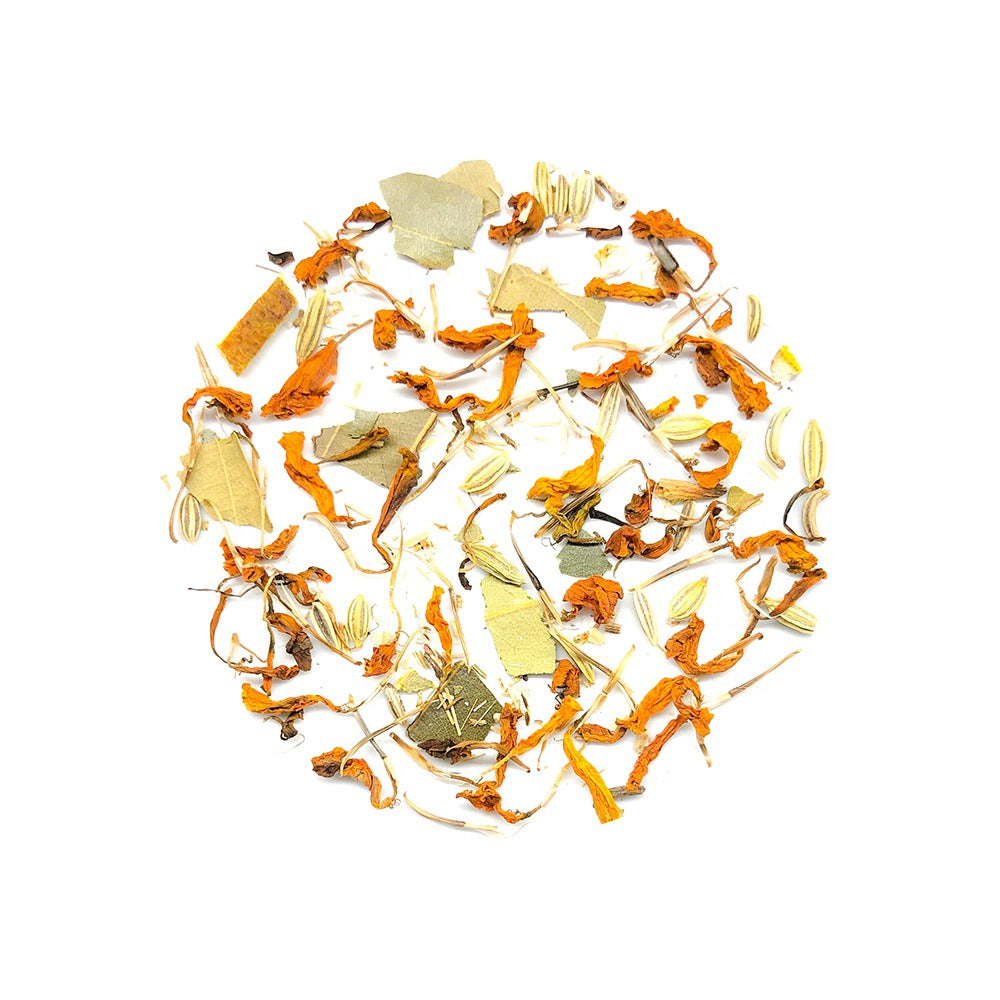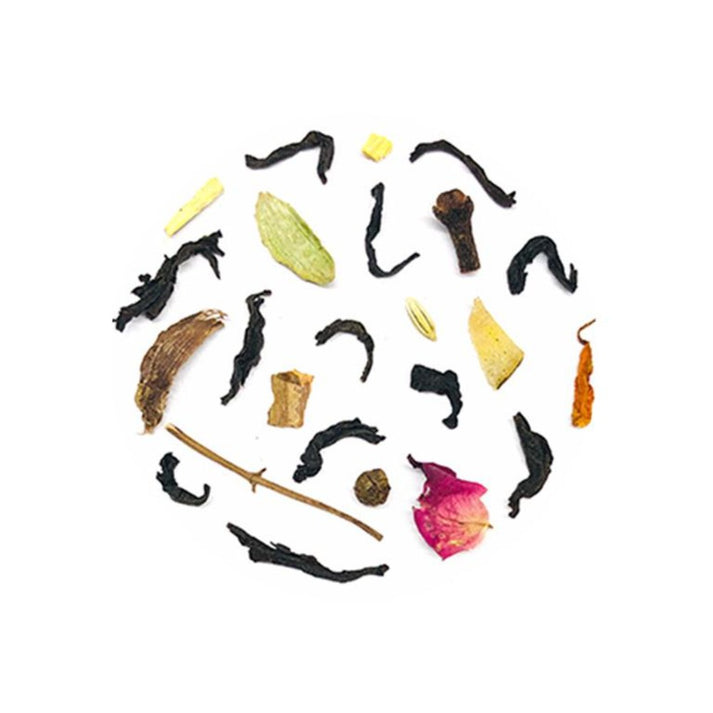The Ultimate Guide to Masala Chai: Crafting India's Beloved Spiced Tea

In a world where coffee shops seem to appear on every corner, a different beverage has been quietly winning hearts: masala chai. This aromatic Indian spiced tea has seen an astronomical 200% growth in global consumption over the past decade, with the U.S. market alone reaching $2.3 billion in 2023. But here's what's fascinating – despite its surging popularity, many have yet to experience the authentic, soul-warming comfort of traditionally prepared masala chai.
Have you ever wondered why this ancient beverage has captured the imagination of the modern world?
The Story Behind Every Cup
Masala chai's journey from Indian street corners to international cafes tells a story of cultural exchange spanning centuries. Its origins trace back over 5,000 years to ancient royal courts, where spiced tea was consumed as a healing beverage in Ayurvedic tradition. However, the chai we know today took shape during the British colonial period, when the addition of black tea leaves to the traditional spice blend created something entirely new.
In homes across India, chai isn't just a beverage – it's a ritual that punctuates daily life, strengthens social bonds, and offers moments of reflection. From dawn to dusk, the rhythmic sound of boiling tea and the aroma of warming spices fills households, small shops, and busy street corners. Each cup represents a pause, a moment of connection, and a tradition passed down through generations.
Why Masala Chai Matters Today
In our fast-paced world, masala chai offers something increasingly precious: a moment of mindful indulgence combined with genuine wellness benefits. The traditional spice blend that gives chai its distinctive character – typically including cardamom, cinnamon, ginger, and black pepper – isn't just about flavor. Each ingredient brings its own health-supporting properties, creating a beverage that's both delicious and beneficial.
Modern wellness enthusiasts are rediscovering what Ayurvedic practitioners have known for millennia: the power of spiced tea to support digestion, boost energy, and promote overall well-being. As more people seek alternatives to coffee and artificial energy drinks, masala chai provides a balanced source of energy through its unique combination of tea, spices, and traditional preparation methods.
What You'll Discover in This Guide
Whether you're new to masala chai or looking to deepen your appreciation, this comprehensive guide will help you:
- Master the art of brewing authentic masala chai
- Understand the role of each ingredient and its benefits
- Create your own signature spice blend
- Navigate the world of tea and spice selection
- Incorporate this healing beverage into your daily routine
Understanding Masala Chai: Beyond the Beverage
What Makes Authentic Masala Chai?
At its heart, masala chai is more than just spiced tea – it's a carefully balanced composition where each element plays a crucial role. The foundation begins with robust black tea, traditionally an Assam variety, which provides a strong base that can stand up to bold spices and rich milk. The spice blend, or masala, typically includes cardamom, cinnamon, ginger, and black pepper, though variations are endless. Finally, the addition of milk and a brewing method that allows all elements to meld together creates the characteristic creamy, spicy, and deeply satisfying beverage.
A Legacy of Tradition and Healing
The evolution of masala chai mirrors India's cultural history. Originally, spiced tea decoctions were used in Ayurvedic medicine to treat various ailments. Each spice was chosen not just for its flavor but for its therapeutic properties. Ginger for digestion, cardamom for breath freshening, cinnamon for circulation – these connections between taste and wellness remain relevant today.
Regional Stories in Every Cup
Just as India's cuisine varies dramatically by region, so too does its chai. In the northern states, you might find chai heavily spiced with cardamom and ginger, while southern variations might include tulsi (holy basil) or lemongrass. The bustling streets of Mumbai offer a different chai experience than the serene tea shops of Kolkata, each reflecting local preferences and available ingredients.
From Street Corners to Global Phenomenon
Today's masala chai exists in many forms, from instant powders to concentrated syrups, but the most remarkable aspect of its evolution is how it has maintained its essential character while adapting to modern tastes. While coffee shop chains have popularized the "chai tea latte," a growing appreciation for authenticity has led many to seek out traditional preparation methods and high-quality ingredients.

The Essential Elements of Chai: Understanding the Building Blocks
The Tea Base: Foundation of Flavor
At the heart of every great masala chai lies its tea base – the canvas upon which all other flavors are painted. Have you ever wondered why some chai tastes more robust and satisfying than others? The secret often lies in the choice of tea.
Selecting the Perfect Tea
Traditional masala chai relies on strong, full-bodied black tea that can hold its own against the potent spice blend and rich milk. Assam tea, grown in India's northeast region, has historically been the preferred choice. Its malty, robust character and deep amber color provide the perfect foundation. This isn't just about tradition – Assam tea's high concentration of theaflavins and thearubigins helps it maintain its character even when combined with milk and spices.
In southern India, planters' grade or CTC (Crush, Tear, Curl) teas are often preferred for their strong flavor and rich color. These processed teas release their flavors quickly and thoroughly during the boiling process, creating the intense tea flavor that characterizes authentic street chai.
Quality Matters
The quality of your tea base significantly impacts the final result. Premium whole leaf teas offer complex flavor profiles but require longer brewing times. Broken leaf grades provide quick flavor release and strong color – ideal for traditional chai preparation methods. The key is finding the right balance between quality and practicality for your brewing style.
Modern interpretations sometimes experiment with different tea bases:
- Darjeeling: Offers a lighter, more floral profile
- Ceylon: Provides bright, citrusy notes
- Nilgiri: Creates a smooth, balanced foundation
The Spice Blend (Masala): Soul of Chai
The masala blend is what transforms ordinary tea into the aromatic elixir we know as chai. Each spice contributes not just flavor but also traditional wellness benefits, creating a beverage that's both delicious and beneficial.
Traditional Spice Architecture
The classic masala blend builds upon four cornerstone spices:
- Cardamom: The defining spice of masala chai, providing sweet, floral notes and aromatherapeutic properties.
- Ginger: Fresh or dried, it adds warmth and pungency while supporting digestion.
- Cinnamon: Contributes sweetness and warmth while helping to balance blood sugar levels.
- Black Peppercorns: Add subtle heat and enhance the bioavailability of other spices.
Secondary spices might include:
- Cloves: Adding depth and warmth
- Fennel: Contributing sweetness and digestive benefits
- Star anise: Providing licorice notes
- Nutmeg: Offering subtle warmth and complexity
Mastering the Balance
The art of masala chai lies in achieving the perfect balance between spices. Traditional ratios typically favor cardamom and ginger as dominant notes, with other spices playing supporting roles. However, these ratios vary by region and personal preference.
A basic starting ratio for a balanced masala blend: Cardamom (4 parts) : Ginger (3 parts) : Cinnamon (2 parts) : Black Pepper (1 part)
Regional Variations Tell a Story
Every region in India has its own signature masala blend, reflecting local tastes and available ingredients:
Northern India often features stronger ginger and cardamom profiles, while Southern variations might include additional spices like lemongrass or tulsi. Mumbai's famous cutting chai typically includes a higher proportion of ginger and black pepper, creating a more invigorating blend.
Quality and Freshness Indicators
The potency of your masala blend depends largely on the quality and freshness of its components. Whole spices, freshly ground before use, provide the most vibrant flavors. While pre-ground spices offer convenience, they begin losing their essential oils – and thus their flavor and beneficial properties – soon after grinding.
Quality indicators for whole spices:
- Strong, characteristic aroma
- Uniform color appropriate to the spice
- Proper size and shape
- Absence of dust or debris
- Appropriate weight for size
The Essential Milk Component: Creating Perfect Harmony
Understanding Milk's Role in Masala Chai
The addition of milk to masala chai isn't just about creating a creamy texture – it's an essential element that helps marry the robust tea base with aromatic spices. Have you ever noticed how the right amount of milk can transform an ordinary chai into something extraordinary?
In traditional Indian chai preparation, whole milk is the gold standard. Its fat content helps extract and carry fat-soluble flavor compounds from the spices, creating a richer, more complex taste profile. The proteins in milk also help soften the natural astringency of black tea, resulting in a smoother, more balanced beverage.
Traditional and Modern Milk Choices
Traditional Indian households typically use buffalo milk, prized for its higher fat content and natural sweetness. However, cow's milk has become the global standard, with whole milk offering the closest approximation to traditional preparations.
Today's chai enthusiasts have embraced a range of alternatives to accommodate different dietary preferences and restrictions. Oat milk has emerged as a popular choice, offering a creamy texture and neutral flavor that complements the spices well. Almond milk adds its own subtle nutty notes, while coconut milk contributes richness and tropical undertones.
Impact on Flavor and Texture
The type of milk you choose significantly influences your chai's final character:
Whole Dairy Milk creates the traditional, rich mouthfeel and helps mellow the spices into a harmonious blend. Its proteins also create the characteristic foam that tops a well-made cup of chai.
Plant-based alternatives each bring their own character: Oat milk provides stability under heat and a subtle sweetness, while almond milk offers a lighter body with nutty undertones. Coconut milk adds tropical notes but can sometimes overpower subtler spices.
Achieving the Perfect Ratio
The ideal milk-to-water ratio typically falls between 1:2 and 1:1, depending on personal preference and milk type. Traditional Indian chai tends toward a higher milk content, while modern interpretations often use less for a lighter finish.

Crafting Perfect Chai: The Art of Preparation
Traditional Method: The Soul of Authentic Chai
The traditional preparation of masala chai is a rhythmic dance of timing and temperature. The process begins with boiling water and fresh spices together, allowing their essential oils to fully release. The tea is then added and allowed to brew to strength, followed by milk and a final boil to achieve the perfect harmony of flavors.
The key steps in traditional preparation:
- First Boil: Spices are simmered in water to extract their flavors
- Tea Addition: Strong black tea is added and allowed to release its full character
- Milk Integration: Milk is added and brought to a boil, creating the signature micro-foam
- Final Simmer: A brief final simmer allows all flavors to meld perfectly
Modern Adaptations for Contemporary Life
While traditional preparation remains the gold standard, modern life sometimes demands adaptations. Contemporary methods focus on maintaining authenticity while accommodating time constraints and different equipment.
One effective modern approach involves creating a concentrated spice and tea base that can be prepared in advance. This base is then combined with freshly heated milk when needed, offering convenience without significantly compromising quality.
Essential Equipment for Success
Creating exceptional chai doesn't require fancy equipment, but a few key tools make a significant difference:
A heavy-bottomed saucepan allows for even heat distribution and prevents burning. A fine-mesh strainer helps achieve the perfect texture, while a long-handled spoon helps manage the brewing process.
Common Challenges and Solutions
Even experienced chai makers occasionally encounter issues. Here are solutions to common challenges:
Bitter Chai often results from over-brewing the tea or using water that's too hot. Solution: Add tea leaves later in the process and maintain a gentle simmer rather than a rolling boil.
Weak Flavor typically stems from insufficient spice extraction or too much milk. Solution: Allow spices to simmer longer initially and adjust your milk ratio.
Curdled Milk usually occurs when cold milk hits very hot tea. Solution: Warm milk slightly before adding it to the chai, or add it more gradually while stirring constantly.
Health Benefits of Masala Chai: Ancient Wisdom Meets Modern Science
Have you ever wondered why a cup of masala chai can make you feel so good? The answer lies in the powerful synergy between its carefully selected ingredients, each contributing to a beverage that's greater than the sum of its parts.
Understanding the Power of Spices
Traditional Indian medicine has long recognized masala chai as more than just a comforting drink. Each spice in the blend serves a specific purpose in supporting overall wellness. Let's explore how these ancient insights align with modern scientific understanding.
Cardamom, often called the "queen of spices," does more than provide its distinctive aroma. Research has shown its effectiveness in supporting digestive health and fresh breath. Modern studies have also revealed its potential in supporting healthy blood sugar levels when consumed regularly.
Ginger, a cornerstone of traditional medicine, brings both warmth and wellness to your cup. Its active compounds, including gingerols and shogaols, have been extensively studied for their anti-inflammatory and digestive properties. Regular ginger consumption has been linked to improved digestion and reduced nausea.
Cinnamon contributes not just its sweet warmth but also powerful antioxidant properties. Modern research has shown its potential in supporting healthy blood sugar levels and cardiovascular health. The type of cinnamon matters – Ceylon cinnamon, while more expensive, is considered the safest for regular consumption.
The Magic of Synergy
What makes masala chai particularly fascinating is how its ingredients work together. The combination of black tea's caffeine with L-theanine creates focused alertness without jitters. Black pepper's piperine enhances the bioavailability of other spices' beneficial compounds, particularly turmeric if it's included in your blend.
Traditional wisdom suggests that the warming nature of chai's spices helps balance the body's energies. Modern science offers an explanation: many of these spices contain compounds that support circulation and metabolism, creating a genuine warming effect.
Contemporary Wellness Applications
Today's health-conscious consumers are rediscovering masala chai as a natural alternative to artificial energy drinks and processed beverages. The blend of sustained energy from tea, combined with the digestive support of spices, makes it an excellent choice for:
- Morning energy and focus
- Post-meal digestive support
- Afternoon relaxation and renewal
- Winter wellness support

Creating Your Signature Blend: The Art of Personal Masala
Foundation of Flavor
Creating your own masala blend allows you to craft a chai that perfectly suits your taste and wellness goals. While traditional ratios provide a starting point, personal preference should guide your final blend.
Start with this basic framework: Four parts cardamom, three parts ginger, two parts cinnamon, and one part black pepper. This creates a balanced blend that honors tradition while remaining adaptable.
Customization for Personal Preference
Consider your taste preferences and wellness goals when adjusting your blend. If you enjoy more warmth, increase the ginger and black pepper. For a sweeter profile, enhance the cinnamon and cardamom. Remember that subtle changes can significantly impact the final flavor.
Seasonal Wisdom
Traditional Ayurvedic wisdom suggests adapting your chai blend to the seasons:
Summer blends might feature more cooling spices like fennel and cardamom, while reducing warming elements like ginger and black pepper.
Winter blends can incorporate more warming spices, perhaps adding cloves or extra ginger for their heating properties.
Proper Storage for Maximum Freshness
The key to maintaining your blend's potency lies in proper storage. Whole spices retain their essential oils and flavors much longer than ground versions. Store your master blend in an airtight glass container away from direct sunlight and heat.
For maximum flavor and freshness:
- Keep whole spices whole until just before use
- Grind small batches as needed
- Check spices regularly for freshness
- Replace your blend every 3-4 months
The Art of Serving and Pairing Masala Chai
Traditional Serving Customs: A Cultural Experience
In India, masala chai is more than a beverage – it's a catalyst for connection and conversation. Have you ever wondered why chai is traditionally served in small portions? This practice, deeply rooted in Indian culture, encourages frequent social interactions and ensures each cup is enjoyed at its perfect temperature.
Traditional serving involves pouring chai between serving vessels from a height, creating a cooling effect and the characteristic frothy top. This method, known as "pulling" the chai, isn't just theatrical – it aerates the tea, enhancing its flavor and texture while bringing it to the ideal drinking temperature.
Understanding Temperature's Role
Temperature plays a crucial role in the chai experience. Traditionally served hot enough to require sipping, this temperature releases the full aroma of the spices while allowing the drinker to appreciate the layers of flavor as they unfold. The ideal serving temperature ranges between 150-160°F (65-71°C), hot enough to be enjoyable but not so hot that it masks the subtle nuances of the spices.
Perfect Pairings: Enhancing the Experience
Masala chai forms natural partnerships with both sweet and savory companions. In India, it's often enjoyed with savory snacks like samosas or pakoras, the spicy tea complementing these crispy treats perfectly. Sweet pairings traditionally include rusks (crisp, sweet biscuits) or nankhatai (Indian shortbread cookies).
Modern pairing suggestions that honor these traditional combinations while embracing contemporary tastes include:
Simple breakfast pairings like oatmeal or toast, where chai's warming spices enhance the meal's comfort factor. Mid-afternoon snacks such as nuts or dark chocolate, which complement chai's complex flavor profile. Evening desserts where chai's spices echo similar notes in baked goods or puddings.
Special Variations: Adapting Tradition
Crafting Dairy-Free Masala Chai
The growing demand for plant-based options has led to creative adaptations of traditional chai. The key to successful dairy-free chai lies in understanding how different milk alternatives interact with tea and spices.
Oat milk has emerged as a favorite alternative, offering a creamy texture and neutral flavor that allows the spices to shine. Coconut milk provides richness but requires careful spice balancing to prevent it from overpowering the blend. Almond milk creates a lighter version that some prefer for afternoon drinking.
Caffeine-Free Alternatives
For those seeking the warming comfort of chai without caffeine, several excellent options exist. Rooibos tea provides a robust base that stands up well to strong spices, while naturally caffeine-free herbals like honeybush offer similar body with distinct character.
Traditional caffeine-free variations often use tulsi (holy basil) as a base, creating a beverage that's both flavorful and adaptogenic. These blends often emphasize the medicinal properties of the spices while providing a satisfying alternative to traditional chai.
Regional Specialties Worth Discovering
Across India, regional variations of masala chai reflect local tastes and ingredients. Mumbai's cutting chai features extra ginger and black pepper for an invigorating boost. Kashmir's noon chai incorporates green tea and a pinch of salt for a unique twist. Kolkata's masala chai often includes bay leaves and sometimes a touch of betel nut for distinct local character.
Modern Interpretations
Contemporary chai culture has spawned creative interpretations that honor tradition while embracing innovation. Chai concentrates offer convenience without compromising quality when properly prepared. Cold-brew chai presents a refreshing summer alternative, while chai-spiced baked goods and desserts bring familiar flavors to new forms.
Making Informed Choices: Your Chai Buying Guide
Have you ever stood in the tea aisle, overwhelmed by choices and wondering how to select the best ingredients for your perfect cup of chai? Let's demystify the process of selecting quality ingredients and understanding what makes exceptional chai.
Selecting Quality Ingredients: The Foundation of Excellence
The journey to exceptional chai begins with careful ingredient selection. When choosing black tea, look for leaves that appear uniform in color and size, with a fresh, bright aroma. Premium Assam or Ceylon teas offer the robust character ideal for traditional chai.
For spices, freshness is paramount. Whole spices should feel heavy for their size and release a strong aroma when lightly crushed. Cardamom pods should be green and plump, while cinnamon sticks should feel dense and slightly brittle rather than soft. Fresh ginger root should be firm with smooth, unwrinkled skin.
Understanding Labels and Certifications
Today's market offers numerous chai products, from traditional loose ingredients to convenient blends. Understanding common labels helps make informed choices:
"Traditional Masala Chai" typically indicates a blend following classic Indian recipes. Organic certification ensures spices are grown without synthetic pesticides, while Fair Trade certification addresses ethical sourcing practices. "Single-Origin" tea bases often provide superior flavor and support sustainable farming practices.
Investment in Quality
While premium ingredients may cost more initially, they often prove more economical in the long run. High-quality whole spices provide more servings per ounce than pre-ground alternatives and maintain their flavor significantly longer. Consider quality ingredients an investment in both flavor and wellness.
TeaAo's Signature Chai Collections
At TeaAo, we've crafted our chai offerings to honour traditional methods while embracing modern convenience. Our signature masala chai blend features hand-selected Assam tea and freshly ground organic spices, promising an authentic chai experience in every cup.
Conclusion: Beginning Your Chai Journey
Essential Takeaways
Masala chai represents more than just a beverage – it's a connection to centuries of tradition, a daily wellness ritual, and a moment of mindful pause in our busy lives. Whether you choose to craft your own blend or rely on carefully curated preparations, understanding the elements of quality chai empowers you to create meaningful tea experiences.
Starting Your Journey
Begin your exploration of authentic masala chai with these straightforward steps:
Start with a traditional blend to understand the classic flavor profile. Experiment with brewing techniques to find your perfect cup. Gradually explore variations and adaptations that suit your taste. Consider chai as part of your daily wellness ritual.
TeaAo's Commitment to Excellence
Our dedication to quality extends beyond ingredients to encompass sustainable practices, ethical sourcing, and ongoing education. Every TeaAo chai blend represents our commitment to preserving traditional chai culture while embracing modern wellness needs.
Your Next Step
Ready to experience the authentic taste of premium masala chai? Visit TeaAo.com to explore our carefully curated chai collections and discover your perfect blend. Use code "TeaAoFirst20" for 20% off your first purchase of any chai collection.
Join our tea community for:
- Expert brewing tips
- Seasonal recipes
- Wellness insights
- Special offers
Contact us at support@teaao.com for personalised recommendations and guidance on your chai journey.
Remember, every cup of chai offers an opportunity to pause, reflect, and connect with a tradition that spans generations. Let TeaAo guide you in discovering the perfect chai for your daily ritual.







